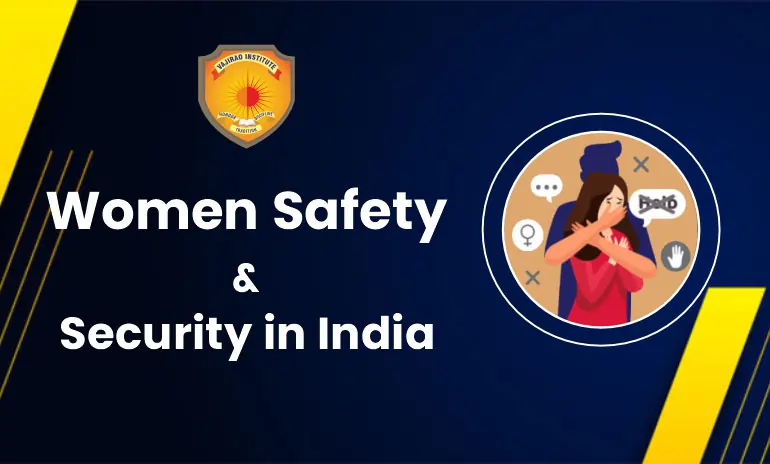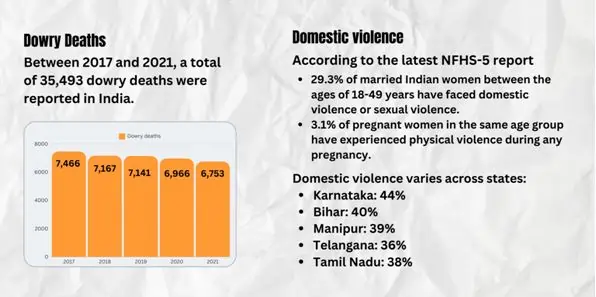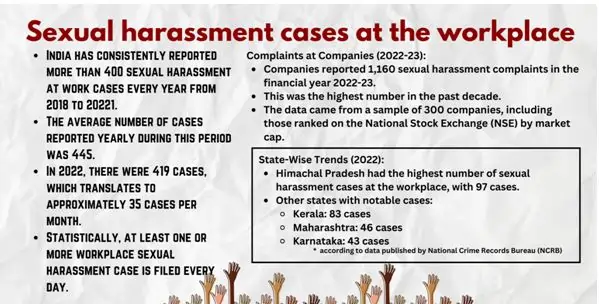
There is still a problem concerning the harassment of women in India even after so many measures put in place across the years. The ghastly acts of crime on women which has occurred recently like the gang rape and murder of a young doctor in Kolkata has reasserted the need for gender safety. Nevertheless, various laws and growing awareness, there are horrific examples of violent crimes against women: domestic violence, sexual assault, and offences related to dowry. India has carried out several law reforms in a bid to try and curb crimes that target women. Thus, the Criminal Law (Amendment) Act, 2013 was a significant step in increasing severity of punishment for the rape and reform in the sentencing standards that regulate sexual crime. However, it is implemented to be a challenge to the aforementioned laws even today. There can be significant time lags with the court and legal actions whilst application of a law is patchy and unreliable with the consequent effect that there isn’t much discouragement for potential villains. One of the major challenges facing the Indian Government in ensuring the safety for women is that many cultures remain strong and hold a patriarchal view in many parts of the country. Female victims are always assumed to be at fault and female liberty is also limited by the norms of the society. The culture that dominates the community presents some difficulties in the fight for justice as well as in search of help for women. It is high time that we look into the current status of the safety of women in India, the challenges faced and what fundamental alterations are required to create a safer environment for the womankind.
Issues related to women Safety
Currently there are several issues regarding woman safety in India. Here are some key issues:
1. Gender-Based Violence:
- Physical Assault: Physical violence such as, domestic violence, sexual assault, assaults involving throwing acid at people continue to unfold.
- Harassment: The second manifestation of gendered innovation is related to marches and perception of women as objects, objectification through street harassment, stalking and unwanted attention in public spaces.
- Dowry-Related Violence: It exposes married women to harassment, abuse and is a major cause of killings related to dowry known as dowry deaths.
2. Limited Mobility and Freedom:
- Social Norms: Patriarchal norms minimize women’s opportunities for movement particularly in the rural settings. They’ve written “for their hearts and their minds” they cannot roam as they are afraid of being judged and/or persecuted.
- Safety Concerns: Panic of being harassed or even attacked puts women in a dilemma of not being able to move around especially at night alone.
- Education Gap: However, there are still deep-rooted problems in the field of education and minorities are mostly affected. The girls are still constrained by factors that hinder them from going to school.
- Workforce Participation: India ranks lowly among the nations in terms of employment of women in the labour force.
3. Lack of Safe Public Spaces:
- Poorly Lit Areas: Lack of proper lighting in the streets increases risk factors particularly when it is in the evening.
- Inadequate Public Transport: Public transport such as buses, trains and the metro are also a danger to woman passengers.
- Lack of Clean and Safe Toilets: There is still no ready provision for Safe Public Toilets especially being women.
4. Cyber security Threats:
- Online Harassment:lot of incidents happening in the era of web related to women’s safety including Cyber bullying, online stalking and Revenge porn etc.
- Privacy Concerns: Every individual deploys personal information online, and this puts the individual at risks of being unsafe.
5. Child Marriage and Early Pregnancy:
- Child Brides: Early marriage puts the girl child at a risk of suffering physical and emotional abuse.
- Health Risks: Early pregnancies are unhealthy to both the mother and the growth of the foetus.
6. Healthcare Disparities:
- Maternal Health: This is so because; there remain high maternal mortality rates attributed to poor health care, particularly during pregnancy and childbirth.
- Access to Reproductive Health Services: Lack of use of FP/RH services has consequences on women’s health.
7. Caste and Religious Discrimination:
- Intersectional Challenges: Such women are even discriminated on other grounds due to their minority status in the community.
- Honour Killings: It also delivers a word of caution to women who marry people from other castes or religions as they are prone to violence by their husbands.
Initiative to overcome these issues
It is the need of the hour that all the associated sectors of society, government, nongovernment organizations, and common people ponder over women’s safety in India. Here are some notable initiatives aimed at improving women’s safety:
- Beti Bachao Beti Padhao (Save the Daughter, Educate the Daughter:these campaigns were initiated by the government of India and form part of its on-going fight against all forms of gender discrimination, especially as regards education for girls. It highlights the need of providing support to girl child from the time they are young.
- Ujjawala Scheme:this scheme launched in the year 2007 to put a stop on the trafficking and exploitation of women. These are a social reintegration and source of livelihood for women who have been trafficked. In indirect manner, by overcoming the risks, it supports the protection of women.
- NIRBHAYA Fund:Created after the Nirbhaya gang rape case of 2012, it funds programmes towards improving the physical security of women. Among others, it supports the establishment of crisis centres, the development of forensic services, and increased police work.
- Ministry of Women and Child Development Initiatives: these are programs to deal with the security of women. These Programs aims to the awareness campaigns and providing legal assistance to victims facing violence. These endeavours are meant to ensure that women’s security is enhanced.
- Safety Measures in Public Transport:182 Helpline a toll free number for women travellers who face any sort of discomfort during travelling by trains.CCTV Surveillance withuse of security cameras in railway stations and compartments.‘R-Mitra’ App a mobile application that will provide women with a button, in case there is a need for them to contact some authority during train travel.
- Safety for Women Tourists:Incredible India Help Linea helpline number provided for women tourists if they are in any problem.
- Safety Measures in Metro Systems:
- Women-Only Coaches: Women too have the problem of harassment in public transport, thus in Metro trains there is a reserved compartments to ensure their safety.
- Reserved Seats: Accommodations for women passengers so as to provide for their comfort and convenience to reduce cases of abuse and harassments.
Domestic Violence and Dowry in India
Domestic violence:
- Prevalence: The intimidation of women has continued to be a leading cause of concern in the society. It includes the physical abuse, emotional abuse and sexual abuse that takes place in homes.
- Correlation with Dowry: The dowry system is prevalent in most societies and especially in societies that practice or tolerate domestic violence. Cases of violence are known to worsen whenever a husband feels that he is not receiving adequate dowers from his wife’s side.
- Legal Framework: It is for this reason that government enactments such as the Dowry Prohibition Act of 1961, bride burning and other types of violence surrounding the dowry issue has continued.
Dowry
- Outlawed but Persistent: India has prohibited the payment of dowry more than 60 years ago or so which suggests the cases are hidden. But in practice, such a tradition remains till today, so much more in rural settings.
- Harassment and Extortion:A number of women are known to be harassed by their husbands’ families, especially new brides, for not having brought enough dowry to the marriage. Unhappily, dowry related disputes lead to women being killed every year with thousands of victims experiencing this cruelty. Most of these are actually premeditated murders that are made to look like the victim caused her death by an accident while cooking.

To eradicate the problems like domestic violence and dowry in India, it is very necessary to take some legal, social and educative measures. Here are some notable initiatives and legislative measures aimed at safeguarding women
- Protection of Women From domestic Violence Act, 2005:to protect woman against the domestic violence. It elaborates the different types of abuse; physical, emotional, sexual, and economic and assists the women to apply for orders for protection, maintenance, and other related remedies.
- Dowry Prohibition Act, 1961:it was to eradicate the Dowry from the Society. It covers provisions that restrain the giving or receiving of dowry and also sanctions anyone who demands or pocket the same. Of course, enforcement still poses a problem despite the creation of the board.
- Indecent Representation of Women (Prohibition) Act, 1986: Such act falling under the Indian Penal Code strictly banned the exploitation of women through advertisements in any form of media as well as the use of women’s images in publications in an indecent demeanour. It designed to avoid sexualisation and to combat negative gender stigmatization.
- The Sexual Harassment of Women at Workplace (Prevention, Prohibition and Redressal) Act, 2013:to resolve the rising incidents of violence or harassment of women at workplace. This also has a provision for the formation of the Internal Complaints Committees (ICCs) in the institutions. This one handles the issues on especial harassment allegations and guarantees women’s protection on the workplace.

- Marriage of Minor Prohibition Act -2006: Though not a dowry law, it is laws meant to protect the girl child from early marriages, pregnancies that expose them to the risks of early deaths due to childbirth complications. This has led to loss of many lives and it mainly focuses on education and letting people know that it is wrong to do it.
- One-Stop Centres (Sakhi): These centres embrace combined care givers of women experiencing violence within the private arenas as well as the public forums. It provides medical assistance, legal aid, counselling and other related service, due to which it becomes easier for the survivors to find help.
What can men do and be for women’s safety?
The participation of men in eradicating abuses carried out to women is very essential and the presence of men will be greatly helpful by:
- Promote Respect and Equality: Armed with this guide, teach boys and young men on how they can respect all women. Promote the sense of justice and sense of acceptance.
- Be an Active Bystander: If you see any aggression or bullying, either in its crudest form or in its subtlest of manifestations, then you need to act safely. The long struggle for women’s rights led to creating a tool to fight and report sexual harassment. Be with women through this process of harassment or assault.
- Educate people:teach about the concept of consent, as well as healthy and unhealthy relationships. This knowledge should be shared.
- Challenge Gender Norms and Roles: men can engage themselves in cleaning activities, taking care of child or even caring for the elderly. This is very effective in eliminating stereotyping of gender roles in the society. Promote women’s right in decision making at home as well as in other social aspects.
- Promote Safe Workplaces: If you are in the management or a committee charged with organizational affairs provide for women safety at the workplace. Encourage those policies which protect the employees against workplace harassment and discrimination.
- Advocate for Legal Reforms: Encourage and call for proper enforcement of laws in as much as they protect the women. It will help in legal awareness and enable people to report cases hence reducing cases of criminal activities.
- Be a Role Model: Ensure that you are polite to the female individuals you come across in your day to day activities. Teach the youngsters what it is like to stand for women’s rights and be their supporter.
Safety of women in India is one of the rising issues which bring out an aspect of development from many angles. Nevertheless, there exists the room for the improvement, although certain advancement has been noted. All the stakeholders beginning from the government, the enforcement authorities, civil society and the public and especially the men should do all they can to make sure that women in India can live their lives without having to worry about such heinous act and being treated with dignity.